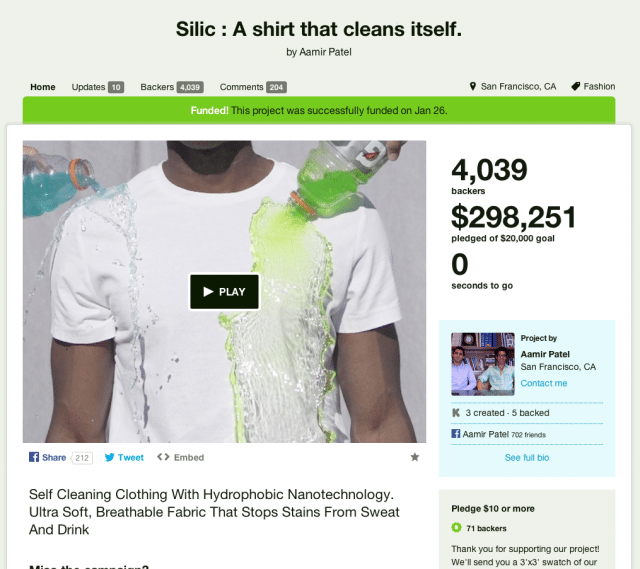How I Raised $298,251 on Kickstarter
By Aamir Patel
February 12, 2014
For an entrepreneur, there isn’t a worse feeling than having an unsuccessful crowdfunding campaign or watching someone with your same idea raise a boatload of money. There are several key points to consider so that you give yourself the greatest chance to succeed. I’ve played the crowdfunding game a few times now and I’ve both failed and succeeded. Now I’m telling you what I’ve learned so that you have the best chance to run a successful crowdfunding campaign.
“I have an idea but I don’t know how to make it.”
That kind of thinking is bullshit. You just haven’t tried to figure it out. The great thing about crowdfunding is that all you need is a concept. On websites like Indiegogo you don’t even need a working prototype; a 3D rendering can raise hundreds of thousands of dollars. Just be aware that if you do raise that kind of money, make sure you can fulfill your promise to your contributors or you will forever tarnish your reputation. Take a note from these Kickstarter campaigns:
- Geode was a great idea but it never came to life since the creator didn’t have sufficient funds. After this project, Kickstarter required working prototypes to be shown.
- Don’t let that discourage you though. On Kickstarter you can fake it till you make it. The guys from ChargeCard showed 3D printed models and designs of a non-working prototype but made people believe it could exist with funding.
- These guys at Mail Pilot killed it by designing the entire thing in powerpoint/html- the code wasn’t even written.
When you have an idea, the first thing to do is to figure out how to get your product made by contacting manufacturers. Often, these people will hang-up the phone or shut the door in your face because of your inexperience, but if you keep trying you’ll eventually meet someone nice enough that can and will help you out. When starting a venture via crowdfunding, networking plays a huge role in terms of finding people who can help you out because they believe in you, not just your idea.
Setting a Goal
Next, you have to do some basic cost accounting for a minimum production run and that will basically set your funding goal. Always set the goal as low as possible when you launch your campaign. I can’t even count how many campaigns I’ve seen where a person raises a decent amount of money to fulfill orders but their campaign fails because they set the goal way too high trying to raise more money than they needed. The point of raising a goal is to save your own neck if you don’t have enough money to make your product- don’t worry about profiting! You want to price your product at the right value but the purpose of Kickstarter is to make your idea come to life, not to make a quick buck.
The best way to price your item is to look at other similar projects out there and figure out where they valued their rewards. Making your product cheaper doesn’t always mean you’ll raise more. Backers are always looking for quality products, not just a cheap novelty. You have to offer them something they can’t find in a mass market store.
Your Video is Your Pitch
I can go on for hours about how the video is the most important aspect of every campaign. I had to learn this the hard way through my three Kickstarter projects (detailed below). The movie is where you want to spend every dollar you can after you have a product to show. $700-$900 is a reasonable budget for someone off Craigslist to come out and do two days of shooting and editing to get a final cut.
Don’t make an infomercial, try tell a story instead. I made this mistake with my second project. We doubled our goal but we could’ve raised much more had I made the project more ‘techie.’ Here are seven points to keep in mind:
- I’ve found that a successful campaign has a very basic format for the Design, Fashion and Technology section.
- Introduce the problem in 10-20 seconds, keep it short, and don’t talk about how the world is going to end.
- Show the solution (your product). It helps to file a $99 provisional patent application on www.legalforce.com so you can call it patent pending.
- Introduce yourself and share your background.
- Talk about the quality and the science behind it as much as much as possible!
- Name Drop, Name Drop, Name Drop.
- Quickly tell the audience why you need the funds and say thank you.
The best way to formulate your script is to go to the “most funded” section of each category and spend a few hours watching all the successful campaign videos. Take elements from each campaign and copy them into your video.
You Will Fail, You Can’t Quit
When my first project failed I was embarrassed and discouraged. Instead of refining and relaunching my project, I gave up. If you don’t make it through a crowdfunding website, it’s not the end. Lots of people have been rejected on Kickstarter and Indiegogo but they stuck to their guns and blew their ideas out of the water by turning to new sites like CrowdTilt and using Facebook to market. Funding is out there for the taking, if you sell your product right you can crowdfund anything.
Check out my previous projects, hope it helps!
First Project (Failed)
Second Project (Raised $22,000)
Third Project (Raised $298,000)
Share this Article
Share this Article
